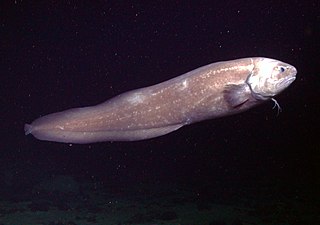Ophidiiformes is an order of ray-finned fish that includes the cusk-eels, pearlfishes, viviparous brotulas, and others. Members of this order have small heads and long slender bodies. They have either smooth scales or no scales, a long dorsal fin and an anal fin that typically runs into the caudal fin. They mostly come from the tropics and subtropics, and live in both freshwater and marine habitats, including abyssal depths. They have adopted a range of feeding methods and lifestyles, including parasitism. The majority are egg-laying, but some are viviparous.

The cusk-eel family, Ophidiidae, is a group of marine bony fishes in the Ophidiiformes order. The scientific name is from the Greek ophis meaning "snake", and refers to their eel-like appearance. True eels, however, diverged from other ray-finned fish during the Jurassic, while cusk-eels are part of the Percomorpha clade, along with tuna, perch, seahorses, and others.

Ogilbia is a genus of viviparous brotulas. The generic name honours the Australian naturalist James Douglas Ogilby (1853-1925), for his contribution to the knowledge of the fishes of Australia.

Saccogaster is a genus of viviparous brotulas. They are found in the western Atlantic and Indo-Pacific.
Barathronus is a genus of deep-sea fish that are placed in the family Aphyonidae or family Bythitidae (brotulas), depending on the source.
Bellottia is a genus of viviparous brotulas which is found in the subtropical waters of the North Atlantic, the Mediterranean Sea and the Indo-Pacific.
Diplacanthopoma is a genus of viviparous brotulas.

Grammonus is a genus of viviparous brotula.

Hephthocara is a small genus of Indo-Pacific viviparous brotula.
Pyramodon is a genus of pearlfishes, with these currently recognized species:
Bassozetus is a genus of cusk-eels found in Atlantic, Indian and Pacific Ocean.
Dicrolene is a genus of cusk-eels.
Glyptophidium is a genus of cusk-eels.
Luciobrotula is a genus of cusk-eels. The larvae have an ovoid body, elongate anterior dorsal-fin ray, and long trailing fleshy filament

Monomitopus is a genus of cusk-eels. They are oviparous.

Otophidium is a genus of cusk-eels, part of the subfamily Ophidiinae in the family Ophidiidae. They are found in the western Atlantic and eastern Pacific.

Sirembo is a genus of cusk-eels of the subfamily Neobythitinae, family Ophidiidae, which are found in the Indian and Pacific Oceans. The species in this genus have a rather robust body with the dorsal fin originating over vertebrae 1–5. The head and bod are completely covered in scales, they have large eyes which are almost equal in diameter to the length of snout, the pelvic fins have two rays which are joined together within an area of tough skin, They have a short spine on the operculum which does not extend to the posterior edge of the head. Their coloration is variable but almost all species have black spots or eyespots on the dorsal fin, sometimes both, while the middle part of the anal fin frequently has a black band. The body and/or head are marked with diagonal or horizontal dark stripes or horizontal rows of quite large dusky spots.
Spottobrotula is a genus of cusk-eels.
Bidenichthys capensis, the freetail brotula, is an uncommon South African fish of the family Bythitidae, and one of three species, and the type species, of the genus Bidenichthys. The species is found in intertidal zones and rocky tidepools ranging from East London to the Cape of Good Hope, South Africa. It grows up to 90 mm long TL.

Brotula barbata, commonly known as the goatsbeard brotula, is a species of cusk-eel in the genus Brotula. It lives in the Indo-Pacific, in depths of up to 300 meters. It is dark brown with a submarginal black band and narrow white border on the dorsal and anal fins versus greenish to orange brown with orange-bordered dorsal and anal fins, and it grows up to be around 100 centimeters. It has a carnivorous diet, and it is oviparous.










